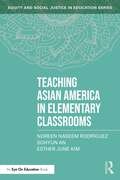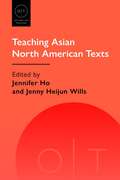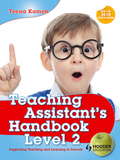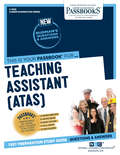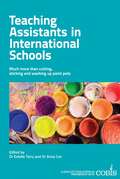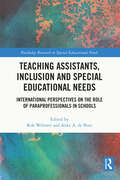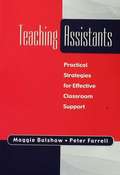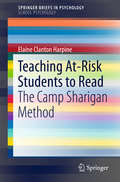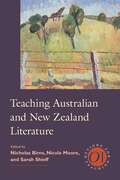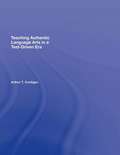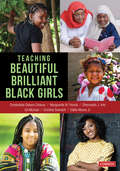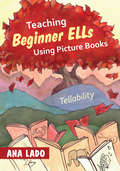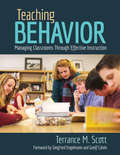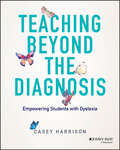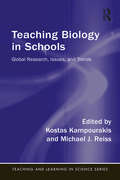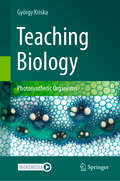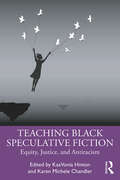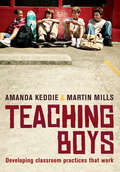- Table View
- List View
Teaching Asian America in Elementary Classrooms (Equity and Social Justice in Education Series)
by Noreen Naseem Rodríguez Soyhun An Esther June KimAsian American voices and experiences are largely absent from elementary curricula. Asian Americans are an extraordinarily diverse group of people, yet are often viewed through stereotypical lenses: as Chinese or Japanese only, as recent immigrants who do not speak English, as exotic foreigners, or as a “model minority” who do well in school. This fundamental misperception of who Asian Americans are begins with young learners―often from what they learn, or do not learn, in school. This book sets out to amend the superficial treatment of Asian American histories in U.S. textbooks and curriculum by providing elementary teachers with a more nuanced, thematically driven account. In chapters focusing on the complexity of Asian American identity, major moments in Asian immigration, war and displacement, issues of citizenship, and Asian American activism, the authors include suggestions across content areas for guided class discussions, ideas for broader units, and recommendations for children’s literature as well as primary sources.
Teaching Asian North American Texts (Options for Teaching #57)
by Jennifer Ho and Jenny Heijun WillsFrom the short stories and journalism of Sui Sin Far to Maxine Hong Kingston's pathbreaking The Woman Warrior to recent popular and critical successes such as Viet Thanh Nguyen's The Sympathizer, Mohsin Hamid's The Reluctant Fundamentalist, and Kevin Kwan's Crazy Rich Asians, Asian North American literature and media encompass a long history and a diverse variety of genres and aesthetic approaches.The essays in this volume provide context for understanding the history of Asian immigrants to the United States and Canada and the experiences of their children, grandchildren, and great-grandchildren. Contributors address historical contexts, from the early enactment of Asian exclusion laws to the xenophobia following 9/11, and provide tools for textual analysis. The essays explore conventionally literary texts, genres such as mystery and speculative fiction, historical documents and legal texts, and visual media including films, photography, and graphic novels, emphasizing the ways that creators have crossed boundaries of genre and produced innovative new forms.
Teaching Assistant's Handbook for Level 2: Supporting Teaching and Learning in Schools
by Teena KamenThis textbook will be the perfect companion to you if you are taking a qualification in Supporting Teaching and Learning in Schools at level 2, whether that is the Award in Support Work in Schools, Certificate in Supporting Teaching and Learning in Schools, or Certificate in Supporting the Wider Curriculum.Teaching Assistant's Handbook for Level 2, offers you a comprehensive and practical guide to supporting the development of children and young people in a variety of educational settings, including primary, secondary and special schools as well as extended schools. The tasks included will develop your personal and professional skill as well as key tasks which will contribute to your assesment.This new edition in updated in line with the revisions made to the specification following the implementation of the Qualifications and Curriculum Framework in 2010, and now mirrors the structure of the units that make up the various Level 2 qualifications.
Teaching Assistant: Passbooks Study Guide (Career Examination Series #C-2845)
by National Learning CorporationThe Teaching Assistant Passbook® prepares you for your test by allowing you to take practice exams in the subjects you need to study. It provides hundreds of questions and answers in the areas that will likely be covered on your upcoming exam, including but not limited to: reading comprehension; writing skills, including grammar, usage and vocabulary; mathematics; and more.
Teaching Assistants in International Schools: More than cutting, sticking and washing up paint pots!
by Anna Cox Estelle TarryWhere would a classroom be without a really great TA? Ask any teacher and they will tell you that the classroom just wouldn't be the same without them. However, a great teaching assistant requires training. This book, published in partnership with the Council of British International Schools, helps demonstrate how TAs can be effective in the classroom and make a real difference to learning.
Teaching Assistants in International Schools: More than cutting, sticking and washing up paint pots!
by Anna Cox Estelle TarryWhere would a classroom be without a really great TA? Ask any teacher and they will tell you that the classroom just wouldn't be the same without them. However, a great teaching assistant requires training. This book, published in partnership with the Council of British International Schools, helps demonstrate how TAs can be effective in the classroom and make a real difference to learning.
Teaching Assistants, Inclusion and Special Educational Needs: International Perspectives on the Role of Paraprofessionals in Schools (Routledge Research in Special Educational Needs)
by Rob Webster Anke A. de BoerThis book offers the first collection of international academic writing on the topic of Teaching Assistants. It serves as an indicative summary of current research and thinking in this field and as a point of departure for future research and development. With contributions from leading researchers, the book draws together empirical work on the deployment and impact of Teaching Assistants from various perspectives and from a range of methodological approaches. It highlights and celebrates the vital everyday contributions Teaching Assistants make to their schools and their communities: from their role within classrooms, to their moment-by-moment interactions with pupils and teachers. The book examines the effect that Teaching Assistants can have on pupils’ learning and wellbeing, and considers issues of overdependence on classroom paraprofessionals and the unintended consequences to which this can lead. Bringing together work from a journal special issue with brand new and updated chapters, the contributions offer insight into the liminal space between educator, care-giver, behaviour manager, and facilitator of learning and of peer relations, which characterises the Teaching Assistant role. This timely and important book will be essential reading for academics, researchers and students interested in special educational needs, disability, and inclusion, and those interested in the wider topic of paraprofessionals in labour markets.
Teaching Assistants: Practical Strategies for Effective Classroom Support
by Maggie BalshawThis practical book is intended to support schools and LEAs in developing effective strategies in working with teaching assistants. It is related to the DfEE's recently published Good Practice Guide (2000). Suggested approaches are supported with real examples from practice, showing the reality of how schools can review and develop practice and so become more effective in their management and support of teaching assistants. The aim is to enable managers in schools and LEAs to work effectively with teaching assistants; teachers to plan classroom approaches for working with teaching assistants; teaching assistants to improve their practice; and children to learn more effectively in inclusive settings. This book will be of use to headteachers, senior staff in schools, SENCOs, LEA support staff, class teachers and teaching assistants.
Teaching At-Risk Students to Read
by Elaine Clanton HarpineThis Brief provides the theoretical foundation of the Camp Sharigan program, while discussing its practical applications and summarizing research studies. It addresses the question often raised in literature and in school-based settings: What is the most effective way to teach children to read? Chapters explore a group-centered approach to correcting reading failure and offers research-based field studies to demonstrate the success of the Camp Sharigan method. The group-centered theory combines learning and counseling into the same program to strengthen education and mental health. In addition, creative-art therapy techniques are also explained and demonstrated. Featured topics in this Brief include: Vowel clustering and its use in improving phonemic awareness. Why group-centered prevention is better for teaching. The importance of cohesion and cohesive-learning in group-centered prevention. The use of individualized rotation to increase motivation and instruction in children who struggle to read. Teaching At-Risk Students to Read is as an essential resource for psychology and educational professionals as well as researchers and graduate students who are interested in improving teaching methods with at-risk students, reducing school dropout rates, increasing intrinsic motivation for struggling readers, changing to an effective method for teaching children to read, improving student engagement, and strengthening self-regulated learning.
Teaching Australian and New Zealand Literature (Options for Teaching #40)
by Nicholas Birns Nicole Moore Sarah ShieffAustralia and New Zealand, united geographically by their location in the South Pacific and linguistically by their English-speaking inhabitants, share the strong bond of hope for cultural diversity and social equality--one often challenged by history, starting with the appropriation of land from their Indigenous peoples. This volume explores significant themes and topics in Australian and New Zealand literature. In their introduction, the editors address both the commonalities and differences between the two nations' literatures by considering literary and historical contexts and by making nuanced connections between the global and the local. Contributors share their experiences teaching literature on the iconic landscape and ecological fragility; stories and perspectives of convicts, migrants, and refugees; and Maori and Aboriginal texts, which add much to the transnational turn.This volume presents a wide array of writers--such as Patrick White, Janet Frame, Katherine Mansfield, Frank Sargeson, Witi Ihimaera, Christina Stead, Allen Curnow, David Malouf, Les Murray, Nam Le, Miles Franklin, Kim Scott, and Sally Morgan--and offers pedagogical tools for teachers to consider issues that include colonial and racial violence, performance traditions, and the role of language and translation. Concluding with a list of resources, this volume serves to support new and experienced instructors alike.
Teaching Authentic Language Arts in a Test-Driven Era
by Arthur T. CostiganMost pre-service education students are enthusiastic about the progressive, constructivist, and student-centered theory and practice advocated in many teacher education programs and by the National Council of Teachers of English. Yet in actual day-to-day practice, teachers often have trouble thinking of ways in which such student-centered and constructivist practices in literacy instruction can be implemented in classrooms which are increasingly driven by high stakes tests, increased accountability, and mandated and even 'teacher proof' scripted curricula. Teaching Authentic Language Arts in a Test-Driven Era provides a powerful and much-needed counterargument to the assumption that test-driven curricula preclude meaningful instruction and authentic student engagement within a Language Arts curriculum. Providing teachers with the theoretical stances and pedagogicals tools to develop a Language Arts practice which can be personally rewarding as well as beneficial to students,Teaching Authentic Language Arts in a Test-Driven Era empowers teachers to be effective even within the confines of a testing- and accountability-driven curriculum.
Teaching Beautiful Brilliant Black Girls
by Eddie Moore Jr. Ali Michael Omobolade Delano-Oriaran Marguerite W. Penick Shemariah J. Arki Orinthia SwindellBe a part of the radical transformation to honor and respect Beautiful Brilliant Black Girls! This book is a collective call to action for educational justice and fairness for all Black Girls – Beautiful, Brilliant. This edited volume focuses on transforming how Black Girls are understood, respected, and taught. Editors and authors intentionally present the harrowing experiences Black Girls endure and provide readers with an understanding of Black Girls’ beauty, talents, and brilliance. This book calls willing and knowledgeable educators to disrupt and transform their learning spaces by presenting: Detailed chapters rooted in scholarship, lived experiences, and practice Activities, recommendations, shorter personal narratives, and poetry honoring Black Girls Resources centering Black female protagonists Companion videos illustrating first-hand experiences of Black Girls and women Tools in authentically connecting with Black Girls so they can do more than survive – they can thrive.
Teaching Beautiful Brilliant Black Girls
by Eddie Moore Jr. Ali Michael Omobolade Delano-Oriaran Marguerite W. Penick Shemariah J. Arki Orinthia SwindellBe a part of the radical transformation to honor and respect Beautiful Brilliant Black Girls! This book is a collective call to action for educational justice and fairness for all Black Girls – Beautiful, Brilliant. This edited volume focuses on transforming how Black Girls are understood, respected, and taught. Editors and authors intentionally present the harrowing experiences Black Girls endure and provide readers with an understanding of Black Girls’ beauty, talents, and brilliance. This book calls willing and knowledgeable educators to disrupt and transform their learning spaces by presenting: Detailed chapters rooted in scholarship, lived experiences, and practice Activities, recommendations, shorter personal narratives, and poetry honoring Black Girls Resources centering Black female protagonists Companion videos illustrating first-hand experiences of Black Girls and women Tools in authentically connecting with Black Girls so they can do more than survive – they can thrive.
Teaching Beginner ELLs Using Picture Books: Tellability
by Ana L. LadoPicture your beginning ELLs reading their way to success! For beginning ELLs, a picture really is worth a thousand words! Picture books are useful tools for building important language and social foundations that students may miss through traditional instruction. Ana Lado provides all the tools you’ll need to engage ELLs of any age with picture books, including how to: Design lessons around picture books Select appropriate titles using specific criteria Incorporate fun and engaging strategies like singing and reenacting Access the book’s searchable online database to find the right book Integrate picture-book learning to facilitate development of English Language Proficiency
Teaching Behavior: Managing Classrooms Through Effective Instruction
by Terrance M. ScottThe key to effective classroom management starts with instruction Every teacher knows that the perfect lesson plan is useless without effective classroom management. But what’s the best way to foster student engagement, differentiate instruction, handle disruptive students, and promote positive behavior? The answer is in how you teach. Teaching Behavior goes well beyond setting classroom rules, communicating consequences, and providing the usual tips on engaging students and building relationships. It draws on the most current evidence-based practices and rich, real-world examples to get to the heart of effective teaching. A national expert in behavior and special education, Terry Scott shares clear, detailed and proven instructional strategies to maximize student success. Teaching Behavior is ideal as a teacher guide or textbook, offering New insights on why instruction is the foundation for all student behavior Practical tools for managing all types of students and classrooms, including the most challenging Self-assessment checklists and discussion questions for teacher book-study groups Wherever you are in your teaching career, Teaching Behavior will give you the innovative, day-to-day tools to conquer the toughest behavior challenges and make your classroom more effective and fun — for you and your students. "Terry Scott provides numerous suggestions for educators who want to teach students ways to address their behavior in order to have a positive impact not only on the students’ conduct but ultimately on their academic success." Marcia B. Imbeau, Ph.D., Professor University of Arkansas "Classroom management is, was, and always will be, of concern to educations. Teaching Behavior is a great springboard for focused dialogue between experienced and beginning teachers on this topic." Sandra Moore, ELA Teacher Coupeville High School
Teaching Behavior: Managing Classrooms Through Effective Instruction
by Terrance M. ScottThe key to effective classroom management starts with instruction Every teacher knows that the perfect lesson plan is useless without effective classroom management. But what’s the best way to foster student engagement, differentiate instruction, handle disruptive students, and promote positive behavior? The answer is in how you teach. Teaching Behavior goes well beyond setting classroom rules, communicating consequences, and providing the usual tips on engaging students and building relationships. It draws on the most current evidence-based practices and rich, real-world examples to get to the heart of effective teaching. A national expert in behavior and special education, Terry Scott shares clear, detailed and proven instructional strategies to maximize student success. Teaching Behavior is ideal as a teacher guide or textbook, offering New insights on why instruction is the foundation for all student behavior Practical tools for managing all types of students and classrooms, including the most challenging Self-assessment checklists and discussion questions for teacher book-study groups Wherever you are in your teaching career, Teaching Behavior will give you the innovative, day-to-day tools to conquer the toughest behavior challenges and make your classroom more effective and fun — for you and your students. "Terry Scott provides numerous suggestions for educators who want to teach students ways to address their behavior in order to have a positive impact not only on the students’ conduct but ultimately on their academic success." Marcia B. Imbeau, Ph.D., Professor University of Arkansas "Classroom management is, was, and always will be, of concern to educations. Teaching Behavior is a great springboard for focused dialogue between experienced and beginning teachers on this topic." Sandra Moore, ELA Teacher Coupeville High School
Teaching Better: Igniting and Sustaining Instructional Improvement
by Bradley A. Ermeling Genevieve J. Graff-ErmelingDiscover the power of collaborative inquiry! This unique, visually stunning resource is packed with details to ignite and sustain the collaborative improvement of teaching and learning. Includes US and international case studies, powerful metaphors, application exercises, a leader’s guide, a companion website, digital templates, and more. Learn what lesson study and collaborative inquiry can and should look like. Find the guidance you need to lead and support schoolwide, inquiry-based improvement! “A true inspiration for educators who want to improve both their own craft and the methods of the profession.” Jim Stigler & James Hiebert, Authors of The Teaching Gap
Teaching Better: Igniting and Sustaining Instructional Improvement
by Bradley A. Ermeling Genevieve J. Graff-ErmelingDiscover the power of collaborative inquiry! This unique, visually stunning resource is packed with details to ignite and sustain the collaborative improvement of teaching and learning. Includes US and international case studies, powerful metaphors, application exercises, a leader’s guide, a companion website, digital templates, and more. Learn what lesson study and collaborative inquiry can and should look like. Find the guidance you need to lead and support schoolwide, inquiry-based improvement! “A true inspiration for educators who want to improve both their own craft and the methods of the profession.” Jim Stigler & James Hiebert, Authors of The Teaching Gap
Teaching Beyond the Diagnosis: Empowering Students with Dyslexia
by Casey HarrisonTips for tailoring instruction and meeting the needs of dyslexic learners Looking through both academic and social-emotional lenses, this book will deepen your understanding of dyslexia and help you feel confident in your interactions and implementation of instruction with your dyslexic learners. Written for educators and schools looking for ways to meet the social and emotional needs of dyslexic learners, scaffold instruction, and successfully implement accommodations, Teaching Beyond the Diagnosis provides a concrete framework for promoting self-confidence and student success. Author Casey Harrison, creator of The Dyslexia Classroom, shares her unique approach to creating dyslexia-friendly classrooms, providing accommodations and in the moment scaffolds as well as helping students build self-advocacy skills. This book will allow you to: Meet the needs of dyslexic learners both academically and emotionally Understand what dyslexia is, how it impacts learning, and what implications it has beyond the reading classroom Learn research-based techniques to enhance, differentiate and scaffold instruction, promoting learning in students with dyslexia Develop empathy and understanding, both in yourself and in the broader educational community, and promote inclusive classrooms This book is for anyone who wants to help students with dyslexia find self-confidence and success: K-12 educators, as well as parents, administrators, and aspiring teachers.
Teaching Biblical Faith: Leading Small Group Bible Studies
by Jack L. SeymourBiblical faith is a lens for viewing life, and Jack Seymour refreshingly illustrates how the reading of scripture is a resource for ongoing theological reflection connecting experience, vocation, daily life, and faith. Teaching has concrete consequences affecting the very ways people of faith view the world and make decisions for living. It matters; it makes a difference in how people think and act. Written in an accessible style, the book provides a manageable way to inspire conversation about the many ways the Bible can be taught, the purposes and outcomes of each approach, and how biblical wisdom shapes personal and corporate decision-making. Useful strategies for leading group Bible study help congregations respond faithfully to the Biblical witness and cultivate a whole congregation approach to Bible study."Seymour provides guidance on what it means to be a teacher and how to teach Christian faith, suggesting that teachers are like animators who envision and enliven the biblical stories and invite people to make connections in life." Narola Ao McFayden, Union Presbyterian Seminary, Richmond, Va. (Interpretation: A Journal of Bible and Theology 71(4)
Teaching Bilingual and EAL Learners in Primary Schools
by Dr Jean ContehShortlisted for the UKLA Academic Book Award 2013! As the number of children learning EAL in primary schools increase, trainee teachers need to develop the professional skills and expertise to teach them. This text reconsiders which children should come under the umbrella of EAL and provides practical strategies for teaching them in an inclusive classroom. It asks 'what do we mean by EAL?' and covers essential theories of learning and approaches to teaching. Chapter topics include; speaking and listening; and reading and writing, and activities and case studies to link theory to practice are provided throughout. About the Transforming Primary QTS Series This series reflects the new, creative way schools are begining to teach, taking a fresh approach to supporting trainees as they work towards primary QTS. Titles provide fully up to date resources focused on teaching a more integrated and inclusive curriculum, and texts draw out meaningful and explicit cross curricular links.
Teaching Biology in Schools: Global Research, Issues, and Trends (Teaching and Learning in Science Series)
by Kostas Kampourakis Michael J. ReissAn indispensable tool for biology teacher educators, researchers, graduate students, and practising teachers, this book presents up-to-date research, addresses common misconceptions, and discusses the pedagogical content knowledge necessary for effective teaching of key topics in biology. Chapters cover core subjects such as molecular biology, genetics, ecology, and biotechnology, and tackle broader issues that cut across topics, such as learning environments, worldviews, and the nature of scientific inquiry and explanation. Written by leading experts on their respective topics from a range of countries across the world, this international book transcends national curricula and highlights global issues, problems, and trends in biology literacy.
Teaching Biology: Photosynthetic Organisms
by György KriskaThe primary aim of the book entitled "Teaching biology - Photosynthetic Organisms" is to support practice-oriented teaching of biology, therefore it includes detailed descriptions of illustrated investigations and experiments alongside basic theoretical knowledge. In line with contemporary requirements, these are complemented by digital aids, such as interactive test exercises. This makes the book a useful tool for not only making observations and carrying out experiments, but also for classroom activities and independent learning. The wide range of exercises can provide a good basis for preparing for competitions and for activities that focus on the independent research work of students. In addition to the simple observations presented in the book, the laboratory exercises are not very time-consuming either and they do not require special materials or equipment. The investigations can be carried out in a school with average equipment.
Teaching Black Speculative Fiction: Equity, Justice, and Antiracism
by KaaVonia Hinton Karen Michele ChandlerTeaching Black Speculative Fiction: Equity, Justice, and Antiracism edited by KaaVonia Hinton and Karen Michele Chandler offers innovative approaches to teaching Black speculative fiction (e.g., science fiction, fantasy, horror) in ways that will inspire middle and high school students to think, talk, and write about issues of equity, justice, and antiracism. The book highlights texts by seminal authors such as Octavia E. Butler and influential and emerging authors, including Nnedi Okorafor, Kacen Callender, B. B. Alston, Tomi Adeyemi, and Bethany C. Morrow.Each chapter in Teaching Black Speculative Fiction: introduces a Black speculative text and its author, describes how the text engages with issues of equity, justice, and/or antiracism, explains and describes how one theory or approach helps elucidate the key text’s concern with equity, justice, and/or antiracism, and offers engaging teaching activities that encourage students to read the focal text; that facilitate exploration of the text and a theoretical lens or critical approach; and that guide students to consider ways to extend the focus on equity, justice, and/or antiracism to action in their own lives and communities.
Teaching Boys: Developing classroom practices that work
by Martin Mills Amanda KeddiePersistently cheeky, disruptive, even aggressive boys can be found in classrooms everywhere, as can the victims of bullying. These boys' behaviours often pose a problem to themselves as well as to others. As the hotly contested debates about boys' education swirl around them, what can teachers actually do to improve boys' performance in the classroom?Teaching Boys provides a practical framework for teachers to improve boys' education in ways that are appropriate for their school context and also sustainable. Drawing on intensive research in classrooms where innovative teachers are achieving good outcomes with boys, Keddie and Mills show how other teachers can learn from their success. They acknowledge that there are no simple solutions, but show that what teachers do in the classroom really does matter. They emphasise the importance of understanding the impact of dominant and subversive masculinities at all levels of schooling, on both boys and girls.'What is original about this book is that it marries theory and practice in a way that speaks to the everyday realities and concerns of teachers who work with boys in schools'Associate Professor Wayne Martino, The University of Western Ontario 'What is impressive about Teaching Boys is the way in which Keddie and Mills pull together the best research on boys and schooling with the best research on pedagogies.'Professor Bob Lingard, The University of Edinburgh
